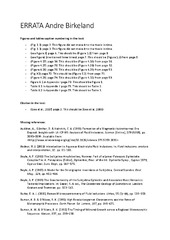| dc.contributor.advisor | Strmic Palinkas, Sabina | |
| dc.contributor.author | Birkeland, Andre | |
| dc.date.accessioned | 2018-06-20T08:53:42Z | |
| dc.date.available | 2018-06-20T08:53:42Z | |
| dc.date.issued | 2018-05-29 | |
| dc.description.abstract | The Sulitjelma deposits, Nordland, Northern Norway, with more than 20 Zn-Cu ore bodies (total tonnage excesses 35 Mt of ore at 1.84 % Cu, 0.86 % Zn, 10 g/t Ag and 0.25 g/t Au) have been described as a classic example of the Zn-Cu volcanogenic massive sulfide (VMS) mineralization.
The mineralization is spatially associated with metamorphosed mafic rocks of Ordovician age. Both, ore bodies and their host rocks, were exposed to deformation processes and recrystallization during the cycle of metamorphism and tectonic transport caused by the Scandian Orogeny. These processes affected ore textures as well as mineral chemistry of ore and gangue minerals.
The aim of this study is to estimate mineralogical, petrological and geochemical characteristics of ore mineralization and associated hydrothermal alteration products and to characterize P-T-X conditions during and after ore deposition.
The mineralization at the Sulitjelma deposits is characterized by predomination of pyrite over other sulfide minerals. The major ore-bearing phases are chalcopyrite and sphalerite. Galena occurs as a major mineral only in the Jakobsbakken ore body. Pyrrhotite predominates in the Sagmo ore body. Ag-sulfides, Fe-oxides and Ti-oxides are common accessory minerals. The major gangue mineral is quartz.
Fluid inclusion studies give an insight into P-T-X characteristics of ore-forming fluids but also revealed several generations of metamorphogenic fluids. Ore-forming conditions are estimated from primary boiling fluid inclusion assemblages indicating the formation temperature between 355 and 370⁰C and formation pressure of 20-24 MPa, or 2000 – 2400 m depth assuming a bulk salinity of 7.5 wt.% NaCl and a hydrostatic regime. Secondary fluid inclusions found in Ny Sulitjelma samples reflect prograde metamorphic conditions, whereas secondary inclusions from Giken rather represented retrograde fluids. The metamorphic conditions at Giken, estimated by a combination of fluid inclusion data and the sphalerite-CuS geothermometer, suggest metamorphic P-T conditions between 570 and 610⁰C and between 350 and 475 MPa, respectively. | en_US |
| dc.identifier.uri | https://hdl.handle.net/10037/12896 | |
| dc.language.iso | eng | en_US |
| dc.publisher | UiT Norges arktiske universitet | en_US |
| dc.publisher | UiT The Arctic University of Norway | en_US |
| dc.rights.accessRights | openAccess | en_US |
| dc.rights.holder | Copyright 2018 The Author(s) | |
| dc.rights.uri | https://creativecommons.org/licenses/by-nc-sa/3.0 | en_US |
| dc.rights | Attribution-NonCommercial-ShareAlike 3.0 Unported (CC BY-NC-SA 3.0) | en_US |
| dc.subject.courseID | GEO-3900 | |
| dc.subject | VDP::Mathematics and natural science: 400::Geosciences: 450 | en_US |
| dc.subject | VDP::Matematikk og Naturvitenskap: 400::Geofag: 450 | en_US |
| dc.title | Ore petrography and fluid evolution in the Cu-(Zn) VMS deposits at Sulitjelma, Northern Norway | en_US |
| dc.type | Master thesis | en_US |
| dc.type | Mastergradsoppgave | en_US |


 English
English norsk
norsk

